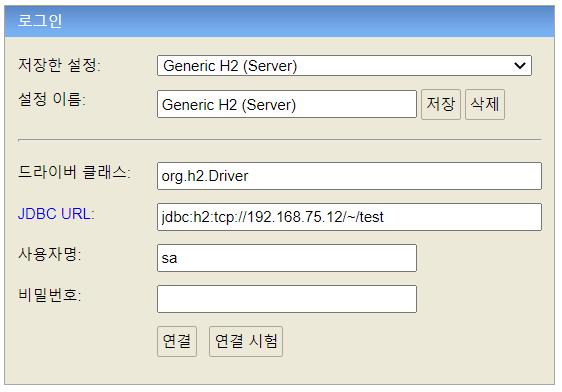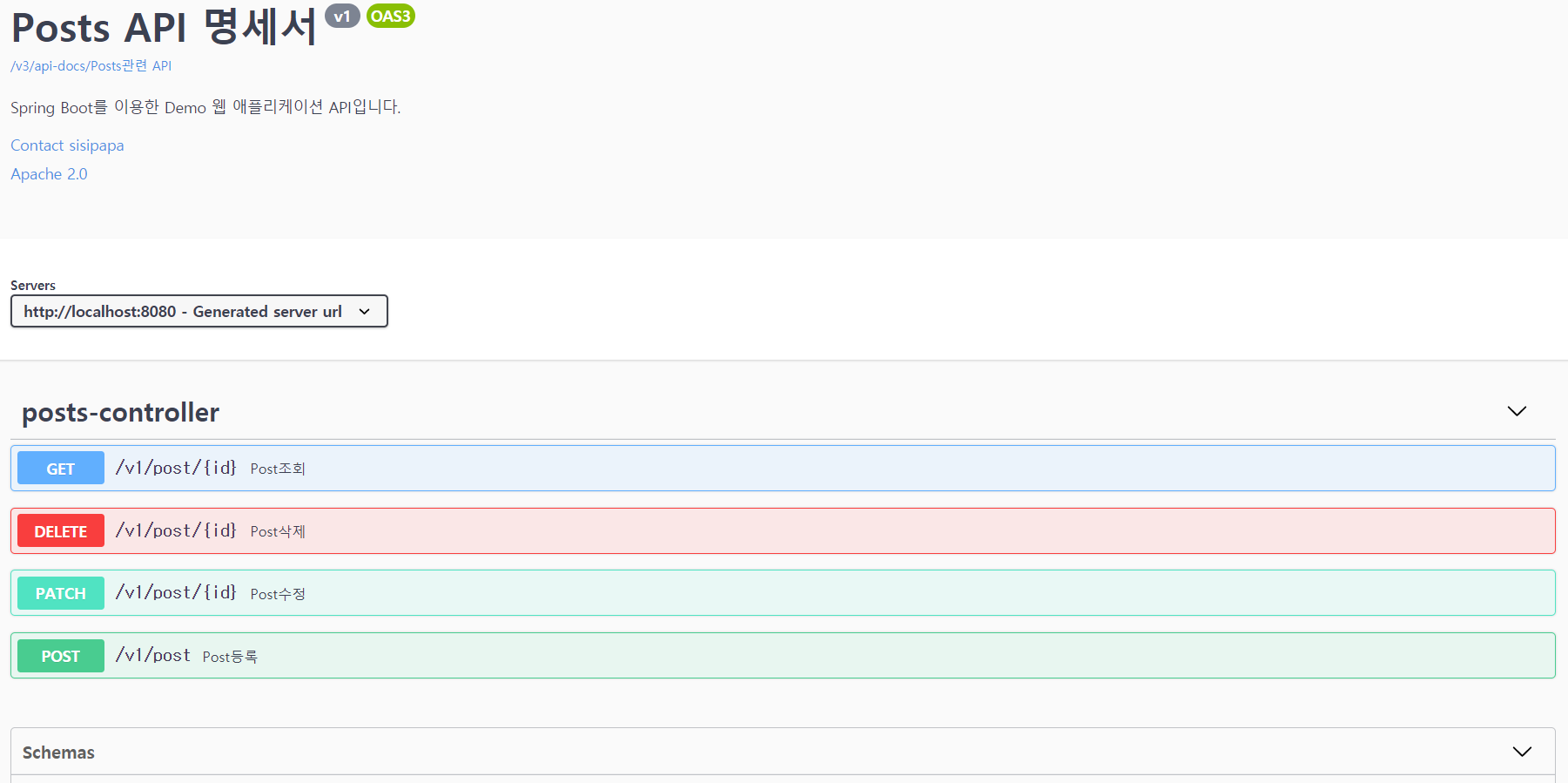Springboot Document 라이브러리1(Swagger)
Springboot+Spring Data JPA+Querydsl+Swagger Rest API
오늘은 Springboot,JPA,QueryDSL,Gradle 환경에서 Rest API를 만들 예정이다.
개발 진행순서는 아래와 같다.
- H2 DB설치
- build.gradle 설정
- application.properties 설정
- Configration 설정
- Rest API 개발(POST,GET,PATCH,DELETE)
- Swagger Doc 확인
1. H2 DB설치
- H2 database 다운로드 후 설치
http://www.h2database.com/html/main.html 페이지에서 OS맞는 설치파일을 다운로드 후 설치한다. - 접속 확인 http://localhost:8082/login.jsp?jsessionid=3ca85e5c51fb926f441f097c1a6d0434
- JDBC URL을 TCP 모드로 세팅후 연결 jdbc:h2:tcp://localhost/~/DB명
2. build.gradle 설정
plugins {
id 'org.springframework.boot' version '2.4.4'
id 'io.spring.dependency-management' version '1.0.11.RELEASE'
id 'com.ewerk.gradle.plugins.querydsl' version '1.0.10' // querydsl 설정 추가
id 'java'
}
dependencies {
runtimeOnly 'com.h2database:h2' // H2 DB설정
implementation 'org.springframework.boot:spring-boot-starter-data-jpa' // spring data JPA
implementation 'com.querydsl:querydsl-jpa' // querydsl 설정
implementation 'org.springdoc:springdoc-openapi-ui:1.2.30' // openapi
}
def querydslDir = '$buildDir/generated/querydsl'
querydsl {
jpa = true
querydslSourcesDir = querydslDir
}
sourceSets {
main.java.srcDir querydslDir
}
configurations {
querydsl.extendsFrom compileClasspath
}
compileQuerydsl {
options.annotationProcessorPath = configurations.querydsl
}
3. application.properties 설정
spring.h2.console.enabled=true
spring.h2.console.path=/h2
spring.jpa.show_sql = true
spring.datasource.url=jdbc:h2:tcp://localhost/~/test;
spring.datasource.driverClassName=org.h2.Driver
spring.datasource.username=sa
spring.datasource.password=
spring.jpa.hibernate.ddl-auto=update
springdoc.api-docs.groups.enabled=true
springdoc.swagger-ui.path=/swagger-ui.html
springdoc.swagger-ui.displayRequestDuration=true
springdoc.swagger-ui.groups-order=DESC
4. Configuration 설정
@OpenAPIDefinition(
info = @Info(
title = "Posts API 명세서",
description = "Spring Boot를 이용한 Demo 웹 애플리케이션 API입니다.",
version = "v1",
contact = @Contact(
name = "sisipapa",
email = "sisipapa239@gmail.com"
),
license = @License(
name = "Apache 2.0",
url = "http://www.apache.org/licenses/LICENSE-2.0.html"
)
)
)
@Configuration
public class OpenApiConfig {
public OpenApiConfig() {
}
@Bean
public GroupedOpenApi postsOpenApi() {
String[] paths = new String[]{"/v1/post/**"};
return GroupedOpenApi.builder().setGroup("Posts관련 API").pathsToMatch(paths).build();
}
}
5. Rest API 개발(POST,GET,PATCH,DELETE)
@AllArgsConstructor
@RequestMapping("/v1")
@RestController
public class PostsController {
private final PostsService service;
/**
* 등록(Create)
* @param dto
* @return
*/
@PostMapping("/post")
@Operation(summary = "Post등록",
description = "Post 레코드를 등록한다.",
responses = {
@ApiResponse(responseCode = "201", description = "post 등록 성공", content = @Content(schema = @Schema(implementation = PostsDTO.class))),
@ApiResponse(responseCode = "500", description = "서버오류", content = @Content(schema = @Schema(implementation = ErrorResponse.class)))
})
public ResponseEntity<? extends BasicResponse> insertPost(@RequestBody PostsDTO dto) {
PostsDTO rDto = service.savePost(dto);
if(rDto == null){
return ResponseEntity.status(HttpStatus.INTERNAL_SERVER_ERROR)
.body(new ErrorResponse("등록 실패", "500"));
}
return ResponseEntity.noContent().build();
}
/**
* 조회(Read)
* @param id
* @return
*/
@GetMapping("/post/{id}")
@Operation(summary = "Post조회",
description = "id를 이용하여 post 레코드를 조회한다.",
responses = {
@ApiResponse(responseCode = "200", description = "post 조회 성공", content = @Content(schema = @Schema(implementation = PostsDTO.class))),
@ApiResponse(responseCode = "404", description = "존재하지 않는 리소스 접근", content = @Content(schema = @Schema(implementation = ErrorResponse.class)))
})
public ResponseEntity<? extends BasicResponse> getPost(@Parameter(name = "id", description = "post 의 id", in = ParameterIn.PATH) @PathVariable Long id) {
PostsDTO dto = service.getPost(id);
if(dto == null) {
return ResponseEntity.status(HttpStatus.NOT_FOUND)
.body(new ErrorResponse("일치하는 정보가 없습니다. id를 확인해주세요."));
}
return ResponseEntity.ok().body(new PostsResponse(dto));
}
/**
* 수정(Update)
* @param dto
* @return
*/
@PatchMapping("/post/{id}")
@Operation(summary = "Post수정",
description = "id의 post 레코드를 수정한다.",
responses = {
@ApiResponse(responseCode = "204", description = "컨텐츠 없음", content = @Content(schema = @Schema(implementation = PostsDTO.class))),
@ApiResponse(responseCode = "404", description = "존재하지 않는 리소스 접근", content = @Content(schema = @Schema(implementation = ErrorResponse.class)))
})
public ResponseEntity<? extends BasicResponse> patchPost(@Parameter(name = "id", description = "post 의 id", in = ParameterIn.PATH) @PathVariable Long id,
@RequestBody PostsDTO dto) {
dto.setId(id);
PostsDTO rDto = service.savePost(dto);
if(rDto == null) {
return ResponseEntity.status(HttpStatus.NOT_FOUND)
.body(new ErrorResponse("일치하는 정보가 없습니다. id를 확인해주세요."));
}
return ResponseEntity.noContent().build();
}
/**
* 삭제(Delete)
* @param id
* @return
*/
@DeleteMapping("/post/{id}")
@Operation(summary = "Post삭제",
description = "id의 post 레코드를 삭제한다.",
responses = {
@ApiResponse(responseCode = "204", description = "컨텐츠 없음", content = @Content(schema = @Schema(implementation = PostsDTO.class))),
@ApiResponse(responseCode = "404", description = "존재하지 않는 리소스 접근", content = @Content(schema = @Schema(implementation = ErrorResponse.class)))
})
public ResponseEntity<? extends BasicResponse> deletePost(@Parameter(name = "id", description = "post 의 id", in = ParameterIn.PATH) @PathVariable Long id) {
if(!service.deletePost(id)) {
return ResponseEntity.status(HttpStatus.NOT_FOUND)
.body(new ErrorResponse("일치하는 정보가 없습니다. id를 확인해주세요."));
}
return ResponseEntity.noContent().build();
}
}

